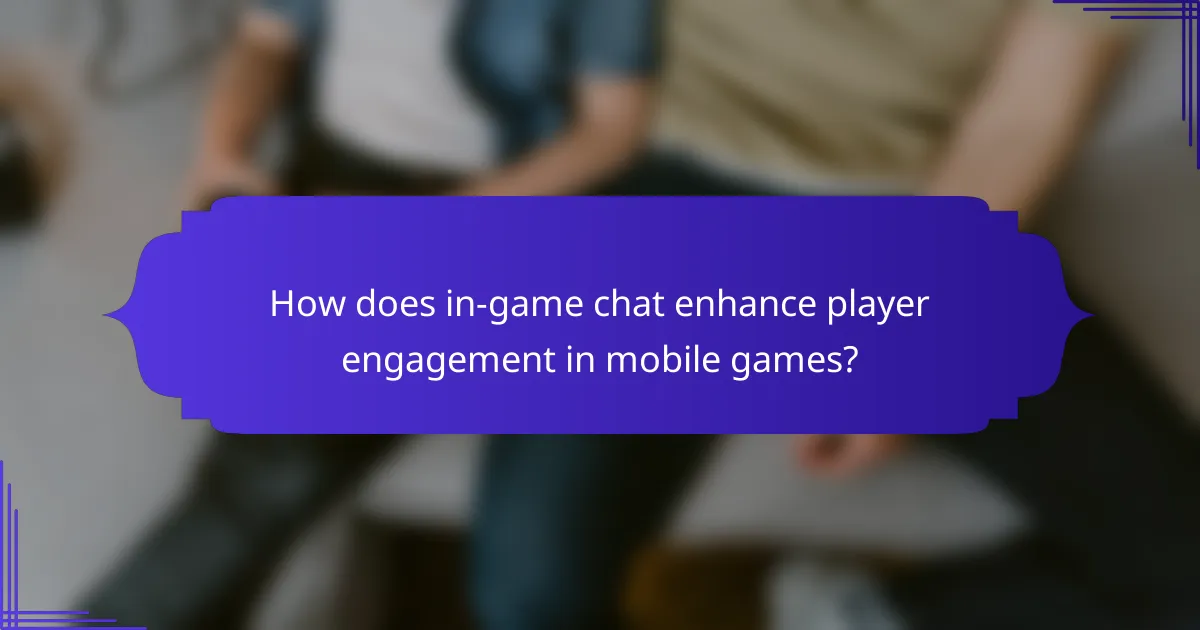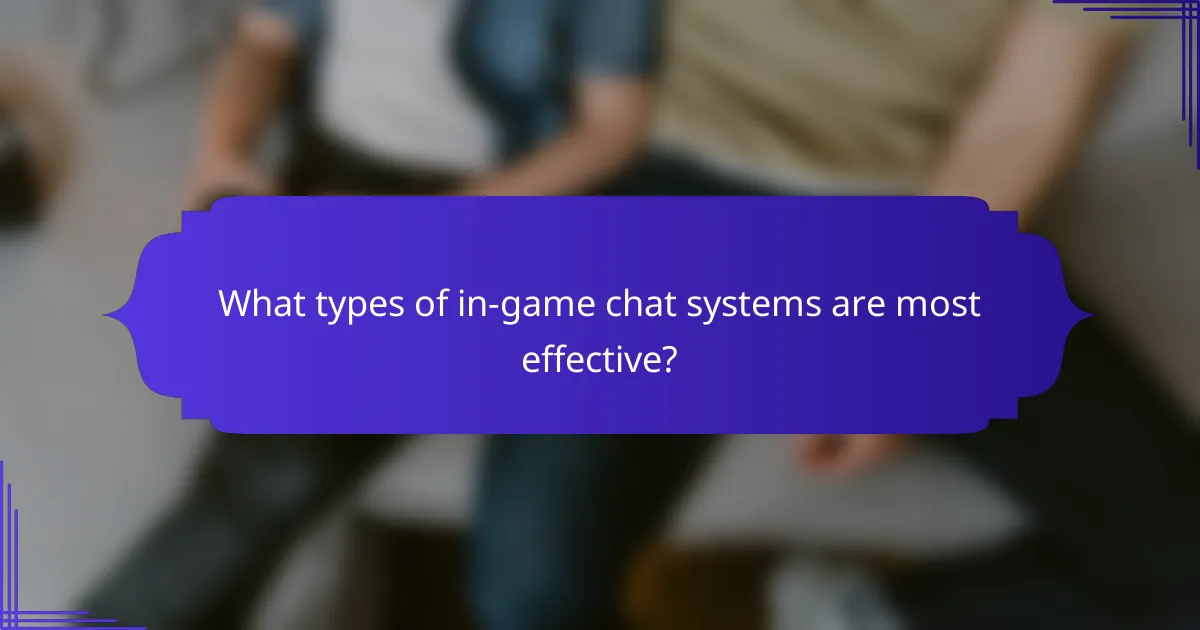In-game chat is a powerful tool for enhancing player engagement in mobile games. It fosters communication, collaboration, and community, leading to increased immersion and retention rates. Effective systems like text and voice chat, along with emote options, facilitate varied interactions. However, developers must navigate challenges such as moderation and regional preferences to maximize the benefits of in-game chat.

How does in-game chat enhance player engagement in mobile games?
In-game chat significantly enhances player engagement in mobile games by fostering communication, collaboration, and community. Players can strategize, share experiences, and build friendships, leading to increased game immersion. Effective chat systems can improve retention rates by creating a sense of belonging. Additionally, real-time interaction encourages players to participate more actively, boosting overall enjoyment and satisfaction.
What are the psychological benefits of real-time communication?
Real-time communication enhances player engagement by fostering social connections and improving teamwork. Players experience increased satisfaction and motivation through instant feedback and interaction. This dynamic environment encourages collaboration, leading to a more immersive gaming experience. Additionally, real-time chat can reduce feelings of isolation, creating a sense of community among players.
Which features of in-game chat drive player retention?
In-game chat features significantly enhance player retention by fostering community and interaction. Key features include real-time messaging, customizable chat options, and moderation tools. Real-time messaging allows players to connect instantly, creating a sense of belonging. Customizable chat enhances user experience by enabling players to tailor interactions. Moderation tools ensure a safe environment, promoting positive engagement. These attributes collectively drive sustained player interest and loyalty.
How does chat influence social dynamics among players?
In-game chat significantly enhances social dynamics among players by fostering communication and collaboration. It creates a sense of community, allowing players to share strategies and experiences. This interaction can lead to stronger team cohesion and increased engagement, as players feel more connected. Additionally, chat features can help mitigate feelings of isolation, particularly in multiplayer environments. Effective communication through chat can improve gameplay outcomes, as teams can coordinate better and adapt to challenges collectively.

What types of in-game chat systems are most effective?
Effective in-game chat systems include text chat, voice chat, and emote systems. Text chat enables detailed communication, while voice chat fosters real-time interaction. Emote systems add a layer of expressiveness without text. These systems enhance player engagement through varied communication forms.
Which platforms support advanced chat functionalities?
Several platforms support advanced chat functionalities in mobile games, enhancing player engagement. Key platforms include Discord, Unity, Unreal Engine, and Photon. These platforms offer features like real-time messaging, voice chat, and customizable chat interfaces, enabling seamless communication among players.
How do different chat formats impact user experience?
Different chat formats significantly enhance user experience by fostering engagement and interaction among players. Text-based chats allow for quick communication, while voice chats provide a more personal touch. Visual elements, such as emojis and GIFs, can make interactions more expressive. In-game chat features, like private messages and group chats, cater to various social dynamics, enhancing collaboration and competition. The choice of chat format influences how players connect, share strategies, and build communities, ultimately impacting retention and satisfaction in mobile games.

What challenges do developers face with in-game chat?
Developers face several challenges with in-game chat, including moderation issues, technical limitations, and user experience concerns. Effective moderation is essential to prevent toxic behavior and ensure a positive environment. Technical limitations can hinder real-time communication, affecting gameplay. User experience concerns arise when chat features distract from gameplay or become overly complex. Addressing these challenges is crucial for enhancing player engagement and satisfaction in mobile games.
How can moderation tools improve chat safety?
Moderation tools enhance chat safety by filtering harmful content and promoting positive interactions. They can automatically detect and block offensive language, spam, or harassment, creating a safer environment for players. This leads to increased player engagement, as users feel more secure while communicating. Effective moderation tools can also provide real-time feedback, allowing players to report issues swiftly, further strengthening community standards.
What are common user complaints regarding chat systems?
Common user complaints regarding chat systems in mobile games include issues such as lag, lack of moderation, and limited functionality. Players often report delays in message delivery, which disrupts real-time communication. Inadequate moderation can lead to toxic behavior, diminishing the gaming experience. Additionally, users frequently express dissatisfaction with the chat interface, citing difficulties in accessing or using features like emojis or private messaging. These complaints highlight the need for improvements in chat system design to enhance player engagement.

How does in-game chat vary across different regions?
In-game chat varies significantly across regions due to cultural preferences and communication styles. For instance, players in Asia often prefer more structured and formal chat environments, while Western players may favor casual and informal interactions. This variation influences player engagement and community dynamics, shaping how players collaborate and socialize during gameplay. Understanding these regional differences can enhance game design and player experience.
What cultural factors influence chat usage in mobile games?
Cultural factors significantly influence chat usage in mobile games by shaping player interactions and engagement. Regional communication styles, social norms, and gaming communities dictate how players utilize chat features. For instance, cultures that emphasize collaboration may see higher chat usage for team strategies, while competitive cultures might focus on taunting or challenging opponents. Additionally, language diversity affects chat dynamics, as players may prefer localized languages or slang, impacting inclusivity and player experience. Understanding these cultural nuances enhances the effectiveness of in-game chat, fostering stronger connections among players.
How do regional preferences shape chat feature development?
Regional preferences significantly influence the development of chat features in mobile games. Developers tailor chat functionalities to meet cultural norms and communication styles of specific regions. For instance, in Asia, players may favor more expressive emojis and stickers, while Western regions might prioritize text-based interactions.
Understanding these preferences enhances player engagement and satisfaction. Customizing chat features can lead to higher retention rates, as players feel more connected to their gaming community. Additionally, language support and moderation tools are critical to ensure a safe and enjoyable environment, reflecting the unique social dynamics of each region.
As a result, regional preferences play a crucial role in shaping chat feature design, ultimately driving player engagement and community building in mobile games.

Which unique attributes make in-game chat memorable?
Unique attributes that make in-game chat memorable include player personalization, real-time interaction, community building, and emotional engagement. Personalization allows players to express their unique identities through custom avatars and chat options. Real-time interaction fosters immediate responses, enhancing the gaming experience. Community building through chat creates a sense of belonging among players. Emotional engagement occurs when players share experiences, strategies, and achievements, making connections that transcend the game itself.
What innovative chat features have recently emerged?
Innovative chat features enhancing player engagement in mobile games include real-time translation, voice-to-text messaging, and customizable chat interfaces. These features foster communication among players across language barriers, streamline conversation, and allow personalization. For example, real-time translation enables players from different regions to interact seamlessly, increasing community interaction. Customizable interfaces let players tailor their chat experience, promoting a sense of ownership and enhancing user satisfaction.
How do personalized chat experiences enhance player loyalty?
Personalized chat experiences significantly enhance player loyalty by fostering deeper connections. Tailored interactions create a sense of belonging, encouraging players to engage more frequently. Personalized communication can include custom greetings, recommendations based on player behavior, and responses that reflect individual preferences. These interactions lead to increased satisfaction and retention, as players feel valued and understood. As a result, personalized chat experiences become a powerful tool in maintaining long-term player engagement in mobile games.

What metrics measure the success of in-game chat?
In-game chat success is measured by engagement metrics, player retention rates, and chat activity levels. Key metrics include message frequency, average response time, and user satisfaction ratings. These indicators reveal how effectively chat enhances player interactions and overall game experience.
Which KPIs are most relevant for evaluating chat effectiveness?
The most relevant KPIs for evaluating chat effectiveness in mobile games include engagement rate, response time, message volume, and player satisfaction scores. These metrics provide insights into how players interact and communicate, enhancing overall player engagement.
| KPI | Description |
|———————-|———————————————–|
| Engagement Rate | Percentage of players using in-game chat |
| Response Time | Average time taken to respond to messages |
| Message Volume | Total number of messages exchanged |
| Player Satisfaction | Ratings or feedback on chat experience |
How can developers leverage data from chat interactions?
Developers can leverage data from chat interactions to enhance player engagement and improve game design. Analyzing chat logs reveals player preferences, social dynamics, and common issues. This data can inform game updates and community features, fostering a more engaging environment. Additionally, real-time feedback from chat can guide developers in balancing gameplay and addressing player concerns promptly.
What best practices optimize in-game chat for player engagement?
To optimize in-game chat for player engagement, implement clear guidelines, encourage interaction, and utilize moderation tools. These practices foster a positive environment, enhance communication, and maintain player interest.
1. Establish clear chat guidelines to promote respectful communication.
2. Encourage players to share experiences, tips, and strategies.
3. Implement moderation tools to manage inappropriate content and maintain a safe environment.
4. Use chat features like emojis and stickers to enhance expression and engagement.
5. Offer rewards for active participation to motivate players to engage more frequently.
What common mistakes should developers avoid when implementing chat features?
Developers should avoid common mistakes like neglecting user privacy, overcomplicating the interface, and failing to provide moderation tools. These errors can hinder player engagement in mobile games.
1. Ignoring user privacy can lead to trust issues, making players hesitant to use chat features.
2. A cluttered interface can overwhelm users, reducing the effectiveness of communication.
3. Lack of moderation tools can result in toxic behavior, driving players away from the game.
4. Not optimizing for mobile can cause lag, frustrating players and disrupting engagement.
